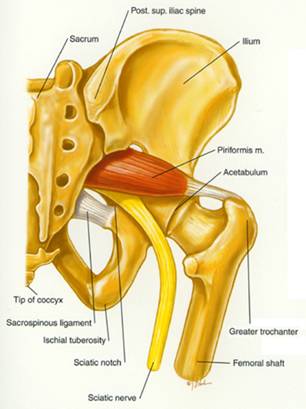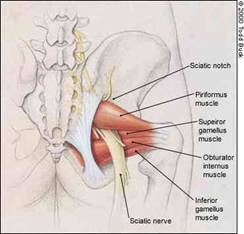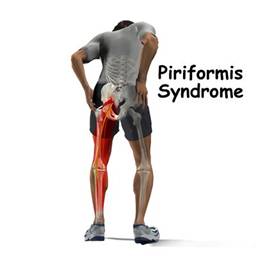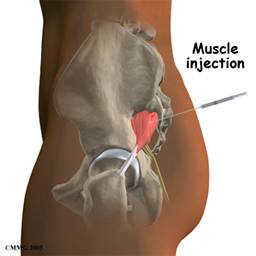 Piriformis syndrome is a painful condition involving a specific muscle in the medial upper buttocks. This muscle is a hip and sacrum stabilizer. Injury, such as a sprain, of the piriformis muscle can cause excruciating pain that is frequently misdiagnosed as a pinched nerve, sciatica or some other condition. A clinician needs to be very familiar with piriformis syndrome to diagnose it. The piriformis muscle is a triangular shaped muscle with the broad based attached along the side of the sacrum. It attaches laterally to the posterior aspect of the femur. For such a small muscle, a sprain can cause excruciating pain. Walking or even weight bearing can trigger severe buttocks pain. Diagnosis can be difficult as this condition can mimic sciatica, but again, there is no “pinched nerve.” The sciatic nerve can run through the lower part of the piriformis muscle but it is the spasm and inflammation of the piriformis muscle that irritates the sciatic nerve, causing sciatica.
Piriformis syndrome is a painful condition involving a specific muscle in the medial upper buttocks. This muscle is a hip and sacrum stabilizer. Injury, such as a sprain, of the piriformis muscle can cause excruciating pain that is frequently misdiagnosed as a pinched nerve, sciatica or some other condition. A clinician needs to be very familiar with piriformis syndrome to diagnose it. The piriformis muscle is a triangular shaped muscle with the broad based attached along the side of the sacrum. It attaches laterally to the posterior aspect of the femur. For such a small muscle, a sprain can cause excruciating pain. Walking or even weight bearing can trigger severe buttocks pain. Diagnosis can be difficult as this condition can mimic sciatica, but again, there is no “pinched nerve.” The sciatic nerve can run through the lower part of the piriformis muscle but it is the spasm and inflammation of the piriformis muscle that irritates the sciatic nerve, causing sciatica.
Sciatica is characterized by pain, numbness and tingling down the back of the leg. If severe enough, EMG studies can sometimes be abnormal.
 Diagnosis is made by a detailed neurological exam. Any history of trauma or sprain to the hip muscles can be a clue to the diagnosis. Most patients have a normal neurological exam. Palpation of the buttocks region show exquisite tenderness over the piriformis muscle. Even light pressure over a severely strained piriformis muscle can cause excruciating pain. Diagnostic studies are usually not necessary.
Diagnosis is made by a detailed neurological exam. Any history of trauma or sprain to the hip muscles can be a clue to the diagnosis. Most patients have a normal neurological exam. Palpation of the buttocks region show exquisite tenderness over the piriformis muscle. Even light pressure over a severely strained piriformis muscle can cause excruciating pain. Diagnostic studies are usually not necessary.

The first line of treatment is physical therapy, with a therapist who is very familiar with the peculiarities of treatment of piriformis syndrome. This combined with anti-inflammatory medications and ice packs can help calm the muscle down. A daily program of stretching the piriformis muscle is an absolute requirement. This stretching must be done indefinitely, as healing a sprained piriformis muscle can take months to over a year.
 In some instances, careful injection of a steroid-anesthetic preparation into the upper piriformis muscle can provide relief. Extreme caution must be exercised so as not to injury the sciatic nerve. Daily stretching and ice pack treatments must continue. For patients that do not respond to these conservative measures, platelet rich plasma (PRP) therapy would be indicated. PRP is able to put a concentrated amount of the body’s own healing mechanism directly into the injured piriformis muscle. The PRP graft initiated healing almost immediately, bringing in bioactive proteins and regenerative cells such as fibroblasts, which lay down new collagen fibers to heal the muscle and tendon. Stem cells are drawn into the area and differentiate into appropriate muscle and tendon tissue. This process takes 4-6 weeks. Remodeling then occurs, shaping and strengthening the new tissue into a stronger healed piriformis muscle. Additional physical therapy 2-3 weeks after the PRP graft has been applied may be of additional benefit. If you have persistent “low back pain”, hip pain or leg pain, see a neurologist familiar with these conditions. Call Sarasota Neurology for consultation for diagnosis and to see if PRP therapy would benefit you.
In some instances, careful injection of a steroid-anesthetic preparation into the upper piriformis muscle can provide relief. Extreme caution must be exercised so as not to injury the sciatic nerve. Daily stretching and ice pack treatments must continue. For patients that do not respond to these conservative measures, platelet rich plasma (PRP) therapy would be indicated. PRP is able to put a concentrated amount of the body’s own healing mechanism directly into the injured piriformis muscle. The PRP graft initiated healing almost immediately, bringing in bioactive proteins and regenerative cells such as fibroblasts, which lay down new collagen fibers to heal the muscle and tendon. Stem cells are drawn into the area and differentiate into appropriate muscle and tendon tissue. This process takes 4-6 weeks. Remodeling then occurs, shaping and strengthening the new tissue into a stronger healed piriformis muscle. Additional physical therapy 2-3 weeks after the PRP graft has been applied may be of additional benefit. If you have persistent “low back pain”, hip pain or leg pain, see a neurologist familiar with these conditions. Call Sarasota Neurology for consultation for diagnosis and to see if PRP therapy would benefit you.
